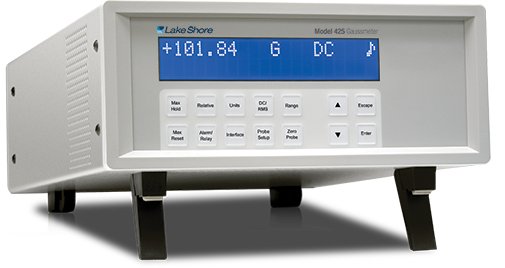Connecting to Lakeshore 425 by Lakeshore in Python
Instrument Card
Lake Shore Model 425 gaussmeter provides high-end functionality and performance in an affordable desktop instrument. Magnet testing and sorting have never been easier. When used in combination with the built-in relay and audible alarm features, the Model 425 takes the guesswork out of pass/fail criteria. Additional features including DC to 10 kHz AC frequency response, max hold and relative measurement make the Model 425 the ideal tool for your manufacturing, quality control and R&D flux density measurement applications. Put the Model 425 gaussmeter to use with confidence knowing it’s supported by industry leading experts in magnet measurement instrument, sensor, and Hall probe technology.

Device Specification: here
Manufacturer card: LAKESHORE

Supporting advanced scientific research, Lake Shore is a leading global innovator in measurement and control solutions.
- Headquarters: Westerville, Ohio, USA
- Yearly Revenue (millions, USD): 21.4
- Vendor Website: here
Connect to the Lakeshore 425 in Python
Read our guide for turning Python scripts into Flojoy nodes.
PROTOCOLS > SCPI
from pymeasure.instruments import Instrumentfrom pymeasure.instruments.validators import strict_discrete_set, truncated_discrete_set
from time import sleepimport numpy as np
class LakeShore425(Instrument): """ Represents the LakeShore 425 Gaussmeter and provides a high-level interface for interacting with the instrument """
field = Instrument.measurement( "RDGFIELD?", """ Returns the field in the current units """ ) unit = Instrument.control( "UNIT?", "UNIT %d", """ A string property that controls the units of the instrument, which can take the values of G, T, Oe, or A/m. """, validator=strict_discrete_set, values={'G': 1, 'T': 2, 'Oe': 3, 'A/m': 4}, map_values=True ) range = Instrument.control( "RANGE?", "RANGE %d", """ A floating point property that controls the field range in units of Gauss, which can take the values 35, 350, 3500, and 35,000 G. """, validator=truncated_discrete_set, values={35: 1, 350: 2, 3500: 3, 35000: 4}, map_values=True )
def __init__(self, adapter, name="LakeShore 425 Gaussmeter", **kwargs): super().__init__( adapter, name, asrl={'write_termination': "\n", 'read_termination': "\n", # from manual 'baud_rate': 57600, 'timeout': 500, 'parity': 1, # odd 'data_bits': 7 }, **kwargs )
def auto_range(self): """ Sets the field range to automatically adjust """ self.write("AUTO")
def dc_mode(self, wideband=True): """ Sets up a steady-state (DC) measurement of the field """ if wideband: self.mode = (1, 0, 1) else: self.mode(1, 0, 2)
def ac_mode(self, wideband=True): """ Sets up a measurement of an oscillating (AC) field """ if wideband: self.mode = (2, 1, 1) else: self.mode = (2, 1, 2)
@property def mode(self): return tuple(self.values("RDGMODE?"))
@mode.setter def mode(self, value): """ Provides access to directly setting the mode, filter, and bandwidth settings """ mode, filter, band = value self.write("RDGMODE %d,%d,%d" % (mode, filter, band))
def zero_probe(self): """ Initiates the zero field sequence to calibrate the probe """ self.write("ZPROBE")
def measure(self, points, has_aborted=lambda: False, delay=1e-3): """Returns the mean and standard deviation of a given number of points while blocking """ data = np.zeros(points, dtype=np.float32) for i in range(points): if has_aborted(): break data[i] = self.field sleep(delay) return data.mean(), data.std()
# Example usagefrom pymeasure.adapters import SerialAdapter
# Create a serial adapter for the instrumentadapter = SerialAdapter(port='COM1')
# Create an instance of the LakeShore425 classgauge = LakeShore425(adapter)
# Set the unit to Gaussgauge.unit = 'G'
# Set the range to 350 Ggauge.range = 350
# Perform a measurement of 10 pointsmean, std = gauge.measure(10)
# Print the resultsprint("Mean: ", mean)print("Standard Deviation: ", std)This script creates a class LakeShore425 that represents the LakeShore 425 Gaussmeter. It provides high-level methods for interacting with the instrument, such as setting the unit, range, and measurement mode. The measure method allows you to perform a measurement of a given number of points and returns the mean and standard deviation of the measured field values.
In the example usage section, a serial adapter is created to connect to the instrument. Then, an instance of the LakeShore425 class is created using the adapter. The unit and range are set, and a measurement of 10 points is performed. The mean and standard deviation are then printed to the console.